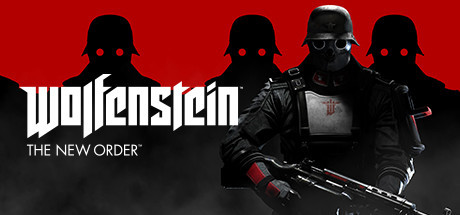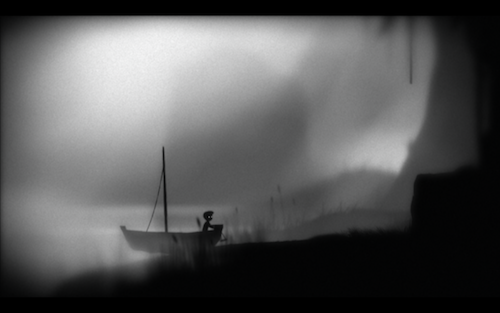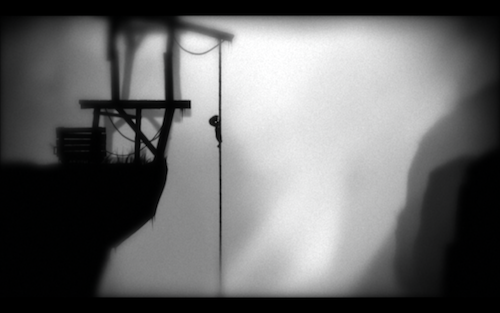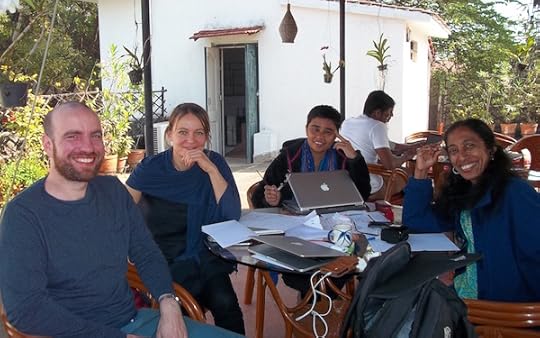Payal Dhar's Blog: Writer's Log, page 4
February 24, 2017
No.6 of #52Stories: Gul in Space
 In 2016, I worked with Pratham Books’ Storyweaver project to commission a set of STEM books. The aim was to create fun, engaging picture books and illustrated books on various technology and engineering themes that could be used as supplementary to textbooks at the elementary level.
In 2016, I worked with Pratham Books’ Storyweaver project to commission a set of STEM books. The aim was to create fun, engaging picture books and illustrated books on various technology and engineering themes that could be used as supplementary to textbooks at the elementary level.
Since Pratham works with children from economically disadvantaged backgrounds, the challenge was to create books that were inclusive and not too urban-centred, and keeping in mind that the text would be translated to many languages. I eventually commissioned four books, the first of which is just out: Richa Jha’s Gul in Space
This is a story in verse about young Gul, who, as a birthday treat, goes for a spin in a rocket, headed to the International Space Station. And, you guessed it, weightlessness strikes! To idea behind the book was to talk about space and zero-gravity environments through Richa Jha’s fun poetry and Lavanya Karthik’s vibrant art work. Take a look at it in full glory:
The book is going to be out in print form soon, but for now is available online at StoryWeaver. For the uninitiated, StoryWeaver is an open-source resource for stories in multiple languages. The stories on the site are available for reading, downloading, printing, translating, illustrating and re-levelling.
All stories and illustrations on StoryWeaver are available under open licenses. Which means we give people the right to share, use or even build upon the creative work that is available here. All tools for translation and formatting are absolutely free. The stories created here are actively shaped and nurtured into being delightful invitations for participation and collaboration – without the chains of restrictive copyright licenses. To read is to free the imagination, to discover new thoughts and ideas.
~PD
February 12, 2017
No.5 of #52Stories: Wolfenstein: The New Order
 When it comes to gaming, it’s always been the story for me, right from the time of Myst and Riven almost 20 years ago. For the most part, give me a story and I’ll be hooked. Of course, the puzzle/discovery content is pretty important too, as is rolling about from cover to cover, sneaking up on or around the bad guys, and sometimes just taking a massive gun and shooting everything in sight.
When it comes to gaming, it’s always been the story for me, right from the time of Myst and Riven almost 20 years ago. For the most part, give me a story and I’ll be hooked. Of course, the puzzle/discovery content is pretty important too, as is rolling about from cover to cover, sneaking up on or around the bad guys, and sometimes just taking a massive gun and shooting everything in sight.
 There’s a lot of shooting everything in sight in Wolfenstein: The New Order (hereafter W:TNO), plus a decent amount of sneaking about if you so wish, but the overarching attraction of the game for me has been the premise its storyline is based on: What if the Nazis won World War II? Indeed, most of the action takes place in a 1960s world where the Nazis have been in power for a decade and a half, and things look very different. Hand in hand with the relentless pursuit of their master race propaganda, the Nazis have also had breakthrough technological advancements, including space travel. Famous cityscapes have changed in a way that you can identify them and yet see that something has gone wrong, very wrong. They also have at their disposal a variety of super-weapons. This means that during the gameplay you get to be chased down by gun-wielding robots the size of tanks, near-indestructible ubersoldaten and mechanical dogs that are anything but cuddly. Retro-scifi, someone called it. Hits the nail on its head.
There’s a lot of shooting everything in sight in Wolfenstein: The New Order (hereafter W:TNO), plus a decent amount of sneaking about if you so wish, but the overarching attraction of the game for me has been the premise its storyline is based on: What if the Nazis won World War II? Indeed, most of the action takes place in a 1960s world where the Nazis have been in power for a decade and a half, and things look very different. Hand in hand with the relentless pursuit of their master race propaganda, the Nazis have also had breakthrough technological advancements, including space travel. Famous cityscapes have changed in a way that you can identify them and yet see that something has gone wrong, very wrong. They also have at their disposal a variety of super-weapons. This means that during the gameplay you get to be chased down by gun-wielding robots the size of tanks, near-indestructible ubersoldaten and mechanical dogs that are anything but cuddly. Retro-scifi, someone called it. Hits the nail on its head.
Our beloved hero B.J. Blazcowicz returns as the main protagonist and the game’s only playable character. Back in Return to Castle Wolfenstein, which was the last game in the series I played, I seem to recall Blazcowicz as a bit of a brainless bullet-happy twit, but in W:TNO, we see a more fleshed-out character. Of course, he still a Nazi-killing machine, but he gets a few quips in, definitely gets to travel, including a trip to the moon, and also a couple of sex scenes.
The story begins in 1946, in the domain of General Wilhelm Strasse (also known as Deathshead). In the prologue, Blazcowicz and two of his colleagues are captured. During their escape attempt a decision has to be made as to which of the colleagues have to be saved, based on which the storyline splits (albeit only in terms of cutscenes). However, the survivors come to grief, and a serious head injury puts Blazcowicz in a coma from which he wakes up 14 years later, in 1960, when the world has changed. The game really gets under way from the time he escapes from the asylum—one of the things that reminds you that this is after all a story is that despite having spent the last decade and a half in a vegetative state, Blazcowicz remains a ripped, deadly, bullet-spewing machine, having lost none of his skills and reflexes—and joins up a flagging Resistance to attempt to take down the Nazis.
The gameplay mostly consists of disposing of various Nazi enemies, both human and robotic. But it isn’t all about breaking down doors and shooting everything in sight. As almost all reviewers and gamers have appreciated, W:TNO’s strength is its writing, not just the story, but the characters and dialogues as well. You fight your way through an asylum, explore underwater tunnels in a U-boat, sneak through a lunar colony (yes, you actually get to walk on the moon), inflitrate and escape a labour camp, sneak into a prison and more. There is not much of a learning curve to the gameplay—the usual FPS mechanics of figuring out how to move, hide, switch between weapons, reload, take cover, sneak, sprint and so on. There is a much-praised lean mechanism while shooting, but for some reason it doesn’t seem to work for me.
One thing I particularly love is that stealth is a major possibility in large parts of the game. It doesn’t seem possible to go an entire level only on stealth, but you can do quite a bit of damage, especially the ability to take out the “commanders” so they can’t call for reinforcements, thus reducing the amount of bloodshed you have to cause. The game’s perk system lets you unlock rewards depending on your play style, which is quite clever. The ability to change difficulty settings mid-level is also rather useful. I usually play on the “normal” setting to get the best of both the story and the challenge. W:TNO’s default “normal” is the third of its five difficulty settings, called “Bring ’em on”, and while it’s not terribly difficult, I have little patience, and have been known to turn it down to “Don’t hurt me” in order to either advance to a part of the story I’m much looking forward to or to get past a particularly tricky section I’m stuck in. Overall, the game runs really smoothly, with no lengthy waits between cutscenes and gameplay—in fact, the transitions seem almost seamless.
Oh, and I am delighted that this is a singleplayer-only game. No idiotic community messages to distract from your gaming pleasure (are you listening, Hitman?).
I still have two more chapters to go before I finish Wolfenstein: The New Order, but I know this is going down in my list of favourites. I mean, how many games let you sneak into a lunar space shuttle and walk on the moon?
Replay value? Definitely.
~PD
February 11, 2017
No.4 of #52Stories: Shatter Me
[NOTE: I feel a little bad roasting this book here, mainly because if you can’t find even one good thing to say, then should you say anything at all? But I’ve run out of patience ploughing through it, so here goes…]
 That hypothetical fine line between the sublime and the ridiculous? There’s a reason one is advised to navigate it with caution. Because sometimes you step out on the wrong side.
That hypothetical fine line between the sublime and the ridiculous? There’s a reason one is advised to navigate it with caution. Because sometimes you step out on the wrong side.
Shatter Me hooked me with its glowing ratings (4-star-plus in Goodreads), but had I cared to read the actual reviews, I’d certainly have given Tahereh Mafi’s trilogy opener a miss. To be fair, it has an interesting premise—a girl whose touch is lethal escapes her confinement at the hands of people who want to use her as a torture device. The storyline, though, follows a predictable path, and every single YA dystopia stereotype and plot device that you could think of is ticked off here.
I’m not going to tax my brain writing about the book. Here’s what the blurb says:
I have a curse
I have a gift
I am a monster
I’m more than human
My touch is lethal
My touch is power
I am their weapon
I will fight back
Juliette hasn’t touched anyone in exactly 264 days.
The last time she did, it was an accident, but The Reestablishment locked her up for murder. No one knows why Juliette’s touch is fatal. As long as she doesn’t hurt anyone else, no one really cares. The world is too busy crumbling to pieces to pay attention to a 17-year-old girl. Diseases are destroying the population, food is hard to find, birds don’t fly anymore, and the clouds are the wrong color.
The Reestablishment said their way was the only way to fix things, so they threw Juliette in a cell. Now so many people are dead that the survivors are whispering war—and The Reestablishment has changed its mind. Maybe Juliette is more than a tortured soul stuffed into a poisonous body. Maybe she’s exactly what they need right now.
Juliette has to make a choice: Be a weapon. Or be a warrior.
I would argue that there’s hardly any original plot in fantasy and the only thing distinguishing the good YA dystopias from the bad ones is the quality of writing. Which is where Shatter Me trips up. The style of writing can best be summed up as “purple prose”, where every second sentence is a metaphor. In fact, the narrative in many parts comprises run-on, punctuation-less, inane analogies that makes you wonder if Harper is suddenly short of editors. Some of the metaphors don’t even make sense and the narrator’s habit of crossing out (sanitizing?) her thoughts get old very fast. Samples:
Every organ in my body falls to the floor.
He’s a hot bath, a short breath, 5 days of summer pressed into 5 fingers writing stories on my body.
His eyes are tight and his forehead pinched, his lips his lips his lips are 2 pieces of frustration forged together. I step backward and 10,000 tiny particles shatter between us.
< br />
I catch the rose petals as they fall from my cheeks, as they float around the frame of my body, as they cover me in something that feels like the absence of courage.
As one Goodreads reviewer aptly summed up, “Shatter Me, otherwise known as: When Creative Writing Class Goes Wrong.” Truly, it does seem like attempted artistic writing gone terribly horribly wrong.
It also includes some YA tropes that I find incredibly off-putting, such as the instant attraction between Juliette and Adam, so much so, that despite having been in solitary confinement for almost a year, the only thoughts Juliette can have when Adam comes close to her are about how hot he is and how she wants to melt like hot butter against his body (yes, really, though I couldn’t find the page for the actual quote). And how, when they’re running for their lives, they must stop for a make-out session.
Adam on his part has also secretly lusted after been in love with Juliette for yonks. That’s not all—Juliette, of course, thinks she’s hideous herself, but in reality she’s “beautiful”, as she’s told by one of the boys. But what is perhaps worst is not even the perfectly predictable story line and flimsy world building, but the fact that Juliette is also a perfect little Mary Sue. Somewhere, it’s clear that she’s imagined as a “good” person with a “terrible” power, but she’ll never harm anyone and she’ll bend but not break. However, what comes across is a damsel in distress who goes weak-kneed in the presence of her “beloved”.
It isn’t really fair to write about a book before you finish reading it, but I couldn’t help myself in this case. I admit that taste is subjective, and one woman’s tripe is another’s artistic wizardy. So I continue to read, and remain in hope of a shattering (pun accidental) twist that will make it all worth it.
~PD
January 24, 2017
Cakes and candles: The 2017 version

Here we go again, time to get excited about turning yet another year older. I’ll be honest: my favourite part about birthdays is cake (chocolate) and presents (many), not necessarily in that order. But because I don’t want to appear shallow, it helps to also make it about reflecting on the year gone by and think about what to expect in the next 365 days.
Here’s what I’d hoped to fill 2016 with:
Implement the new design for Writeside.net. (It got a bit complicated. Long story.)
Finish writing a book. (DONE, DONE and DONE! Yep, got two coming out this year, one an MG novel and the other a collaborative effort with another author. The US edition of Eat the Sky, Drink the Ocean is also out this year.)
Stay healthier than I managed in 2015. (Oops, that one might have come undone a bit.)
Travel somewhere fun. (Done. Spent two weeks in the UK)
Work on the workshops.(Done! Devika Rangachari and I started Royal Blue. We did three independent workshops, and have just wrapped up a 15-session creative writing programme in Amity International School, Saket, New Delhi.)
Play more games. (Done! Would have been nice to get a bit more time for gaming, but shouldn’t complain.)
So, all in all, not as bad as it could have been.
But it’s that day again, so time for a brand new list, with new resolutions and aims. Here goes:
Write (and/or finish) a fantasy novel: At the moment I don’t care if it’s one of my unfinished projects or series, or a new standalone novel. I just want to get back into fantasy.
Start running again: Okay, I know realistically there isn’t a chance in hell of this happening if I continue to live in Delhi and if my knees don’t magically regenerate, so let’s downgrade this to “get fit enough so I can theoretically start running again”.
Redo Writeside.net: Not just a new design, but maybe rethink what I’m doing with the site.
Blog regularly: Plan in place.
Keep playing games: My huge gaming backlog is getting huger as I keep buying games but not playing quite so much. But I’m going to do my best.
Try self-publishing: Stay tuned for more on this.
Travel somewhere interesting: As usual.
That’s all folks. Let’s see where we are 365 days from now.
~PD
No.3 of #52Stories: My Sister Rosa
 I had wanted to read Justine Larbalestier’s My Sister Rosa right from the time I’d heard about it and read a preview chapter. A book about a 10-year-old psychopath who everyone believes is the cutest and most precocious thing on earth, but who is actually a dangerous and intelligent human being, without a conscience. What’s not to like?! Here’s a teaser from the review:
I had wanted to read Justine Larbalestier’s My Sister Rosa right from the time I’d heard about it and read a preview chapter. A book about a 10-year-old psychopath who everyone believes is the cutest and most precocious thing on earth, but who is actually a dangerous and intelligent human being, without a conscience. What’s not to like?! Here’s a teaser from the review:
What makes Rosa even more dangerous is that she has already figured out how to pass for “normal”. And in her young life she has already left a wake of destruction that everyone around her seems completely blind to. Only Che knows—and he has been watching and documenting Rosa for years—that the things that happen around her have all been carefully orchestrated and manipulated by her. Worse, her psychopathic behaviour is escalating, and that terrifies Che, because he knows that next time someone is going to die.
Read the full review here
Well, what do you think?
~PD
January 19, 2017
No.2 of #52Stories: A tale of many stories
 Between September 2016 and January 2017, Devika Rangachari and I conducted a series of 15 sessions on creative writing at Amity International School, Saket, New Delhi, under our Royal Blue banner. The participants were 50-odd students of class VIII, approximately 13 years old, selected by the school to be part of the programme. The aim was to guide them in the basic craft of writing fiction and select the best stories written by the children to be published in an anthology (by the publishing wing of Amity).
Between September 2016 and January 2017, Devika Rangachari and I conducted a series of 15 sessions on creative writing at Amity International School, Saket, New Delhi, under our Royal Blue banner. The participants were 50-odd students of class VIII, approximately 13 years old, selected by the school to be part of the programme. The aim was to guide them in the basic craft of writing fiction and select the best stories written by the children to be published in an anthology (by the publishing wing of Amity).
While we’ve been conducting one-off creative writing sessions, this was the first long-term programme we’ve worked on (and we certainly hope it won’t be the last). Sharing the “secrets” of cobbling together a good story is always a fun experience, and having an enthusiastic audience always helps. Out of the original 50, about 25 or 30 eventually went on to finish the workshop (though, it must be said, some were erratic as other school activities coincided with our sessions), and 21 stories were selected for the anthology. According to the students’ feedback, they enjoyed the workshop and most of them did say it helped them write better. One or two also professed to developing an interest in reading fiction.
As for us, we learnt quite a bit too, and noticed some interesting things:
Teenagers are quite amenable to being pushed into writing provided you make it interesting for them. However, they seem to respond more to a carrot-and-stick method than an open-ended, write-if-you-want to directive. Our rigid school system is to blame for this, as it seems to train them to deliver only if there’s a punishment or reward at the end of the assignment.
Of the 50 students who were crammed into this session, perhaps 10 or 20 were really interested in writing. In an ideal system, this should have been a voluntary workshop. Also, even though we were the ones to put a cap of 50, the sessions worked much better when there were fewer kids as they were more interactive (and the students too said the same in their feedback).
There was a bizarre preoccupation with death! A significant number of the stories submitted and read out over the course of the workshop had to do with death, dying, killing, suicide. Is it because, at 13, dying doesn’t seem as real because, well, you’re only 13? Many of the stories were also about being alone, being left alone, not having any family or losing/finding one’s family. That was more understandable.
Most, with the exception of one or two, featured Western (American) settings and characters. It was interesting, because this is something that I did too when writing as a teen (only, my settings and protagonists were British as that was the fiction I’d grown up reading). This underlines the importance of representation of one’s own culture, environment or whatever you want to call it. These kids have grown up reading, and are reading, books based in the West, and seem to be unable to imagine stories based in their realities. Somewhere in their heads (as it was in mine when I was 13), to be in a story, you have to belong to that “world”, an imaginary, aspirational one they have imagined from the stories they have been reading. It is by no means a bad thing to set your story in a different culture or have characters who are not like you, but when that setting becomes the same, monolithic one, and the characters sound eerily unreal, it deserves some attention. (Discussing this will have to be a whole new blog post!)
Even though Indian students are trained to respond like trained dogs—they’ll do something if not doing it means there will be a punishment—it doesn’t mean they’re above a bit of cheating to get there. Quite a few of the submitted stories were printed straight from the Web. Unfortunately, they didn’t realize that it is easier for us to check for plaigairism than it is for them to find, download and print stories. In their defence, after a long lecture on how copyright violation is a crime for which one can go to jail, most of them did withdraw their stories.
A surprising number of stories featured older protagonists, that is, these 13-year-olds were writing as adults, with what they thought were adult voices.
And finally, the language skills of these class VIII students were appalling! With the exception of about three or four, not one could write a complete grammatically correct sentence. This was surprising as quite a few of them read quite a bit. What was more surprising was that the school didn’t seem particularly concerned about this in general.
It would be really interesting to find out if these observations were peculiar to this bunch of students or if they are a general statement on the middle-class, English-educated 13-year-olds in Delhi. I suppose we may find out eventually.
~PD
January 16, 2017
No. 1 of #52Stories: Limbo
 You know that feeling of being in a dream, where the world feels a bit out of focus, where everything is just a little out of reach, and where you have a sense of knowing that you have to go on but no idea why? Well, Limbo is sort of like that. I would go so far as to say that it’s a work of art, one whose its strength lies in its simplicity.
You know that feeling of being in a dream, where the world feels a bit out of focus, where everything is just a little out of reach, and where you have a sense of knowing that you have to go on but no idea why? Well, Limbo is sort of like that. I would go so far as to say that it’s a work of art, one whose its strength lies in its simplicity.

Limbo dates back to 2010, developed by the independent Danish studio Playdead (who have since brought out another, very similar game called INSIDE in 2016). It is a puzzle platformer, but nothing like you’ve ever seen before. In Limbo the player controls the protagonist, a little boy who wakes up on the floor of a forest. You don’t have any information about who he is or what he is supposed to do; you can’t even point and click at things. All you have are the arrow and alt keys to make him move, jump and interact with his environment, that is, push and pull.
The gameplay takes place in the aforementioned forest, a vile, menacing space. The forest is full of dark shadows and blurry shapes. As the boy goes deeper into this nebulous, murky world, he confronts untold dangers and seemingly insurmountable obstacles. But he must keep going—who knows where and why. This incongruity of a seemingly innocent little boy along among the concealed dangers of this surreal world is what gives Limbo its edge and you, the player, a chill down your spine.

The artwork is hauntingly engaging—silhouettes in shades of grey, used beautifully to convey a sense of depth. The cute-creepy little protagonist is but a solid featureless figure with two bright spots as eyes. The foreground in which the action takes place is also in dark silhouette, and lighter greys are used to convey depth and layers, while light streams in to create soft shadows and highlight dust motes, and underline that sense of dreaminess. But the softness of the environment is skin deep, for you don’t need to go too far to find the menace in Limbo. You must steel yourself to watch the little boy fall, and by that I mean die, and die in gruesome ways. There’s no blood, no mourning. He just gets up and tries again.
Death is serious in Limbo. Timing and the environment are all you have to bridge unpassable terrain, to keep going, to defeat the vile creatures that bar your way, and to bypass the deadly traps that will sever your protagonist’s limbs. Yes, the deaths can be grisly—you watch the kid getting snapped in two, decapitated, skwered by the legs of a giant spider; you watch him go limp when he falls into water, you watch his body crumple when he falls from a height. You don’t need graphic imagery to recoil when steel traps squelchily snap the little body into pieces or when all sounds stop as water engulfs the boy and he stops moving.
Gameplay-wise, there’s a fair bit of trial and error to get past certain sections, made a little bit harder because you know that every failure means you have to watch the grim death scene again. And, of course, the puzzles do get harder as you go on. Thanks to the short chapters, there are frequent autosaves, meaning that you don’t always have to redo a really complex bit that you just about managed after many tries.
Since I have yet to get to the end of Limbo, I don’t yet know what the story will unfold. It’s already one of my favourite games of the year and it’s still the first half of January.
~PD
January 7, 2017
Introducing: 52 stories of 2017
 It turns out that the only tried and tested method of regular blogging is to give myself a goal. And so, the theme for this year is “52 stories”.
It turns out that the only tried and tested method of regular blogging is to give myself a goal. And so, the theme for this year is “52 stories”.
Posts will be about about books, games, TV or anything else that has a story in it, mostly reviews, but maybe a bit about writing, and perhaps teaching writing (fiction) as well. The magic number is 52—in other words, there will (should) be a post every week (or so).
The inspiration for this year’s blogging theme comes from having spent 10 days at the “Children Understand More…” residency organized by the the Goethe-Institut India/Max Mueller Bhavan and Zubaan in Shantiniketan. Seventeen writers and illustrators came together at the idyllic Mitali Homestay in the land of Rabindranath Tagore to brainstorm and work on creating some quality children’s literature. All constraints, perceived or real, were removed, and the participants were free to explore themes and ideas that one customarily baulks from introducting to children. Along with Nadia Budde, Ben Dammers and Devika Rangachari, I was one of the mentors at the residency, tasked with helping the participants tease out workable ideas and shape them into works-in-progess that would eventually—hopefully—end up as published books.

This mentoring business is hard work…
Most of the participants rose to the challenge and a variety of fantastic books-in-the-making resulted. Some new talents were discovered, such as one writer discovering she was an artist too, and another writer finding a superbly edgy YA voice. Divested of the hindrance of thinking about the feasibility of being “publishable” and marketable, it created an atmosphere in which only the stories mattered. Among the themes that were batted around were religion and fear; identity; family, society and relationships; death; body image; mental illness; puberty; and climate change. Some worked individually, others collaborated, and most brainstormed and sought out critiques on their works-in-progress.*
Needless to say, it is impossible to come back from such an experience unmoved. The possibility of some or all of these ideas turning into books in the not-so-far future was exciting enough, but more than that, spending almost two weeks in the company of a group of talented artists, writers and storytellers was super-inspiring. And not insignificant was the fact that being cut off from the mundanities of one’s daily life, talking and thinking only about creating fiction for children, did inject a good dose of reassurance regarding the work one has been doing (or attempting to).
Which brings me back to the blogging theme of 2017. Yes, stories are important, critically important, in our understanding of our world, whether we’re writing them, reading them, watching them, taking part in them. And reading is not the only way in which we engage with stories.
So, strap on your seatbelt.
~PD
*To know more about the Children Understand More residency, read Bijal Vachharajani’s write-up.
January 5, 2017
Why, hello, 2017! Here already?
Over the past few years, I find that we (my contemporaries and I, that is) have been talking more and more about how the years are ticking by faster than ever before. As it turns out, this is an obligatory topic of conversation that becomes increasingly important as one gets older (move over, weather). Scientists have even been studying it and coming up with theories on why this is so.
My favourite theory is that the older you get, the years are proportionately smaller. So, when you’re 10, a year is a 10th of your life; when you’re 40, it’s only a 40th. Add to that my personal ability to spend copious amounts of time doing absolutely nothing, this means that 2017 is likely to race by tamely. Thus, am taking the chance here to declare that 2017 will be a year of blogging. Yes, it will!
Back in 2015 I’d promised myself one short story a month. Please feel free to insert an eyeroll here. Alarmingly enough, I’m not even sure what I’d resolved for 2016, and judging by the almost-criminal neglect of the blog, it’s perhaps a subject one should leave aside.
What what’s the plan for 2017? Well, a weekly blogging plan is on the agenda, the subject will be revealed in a day or so.
Meanwhile, Happy New Year, world.
~PD
August 13, 2016
I’ll take the book, thank you
(NOTE: This blog post topic is brought to you by Marie: “Least favourite book to movie adaptation”. For the purposes of this post, I’m going to pretend that movie and TV series are the same thing.)
I started reading Stephen King’s Under the Dome after having watched the first few episodes of the TV series. It wasn’t that the TV series was bad—apart from the fact that Julia Shumway and Barbie were super-irritating—but the book dragged me in and swept me away. After that, going back to the series was frustrating and I eventually gave it up.
There may be spoilers below for the book.
So what was so terrible about the series? Hard to say—perhaps without the book, it would have kept me hooked. But if you thought that moving picture is worth tens of thousands of words, you are mistaken. First, there is Stephen King’s writing. In the book, though the cool slicing of the cow in half doesn’t happen, the disaster is so much more palpable; watching it seemed like they were doing things just for the spectacle of it.
Also, the characters. Julia Shumway was dolled up in the series, making her a younger woman, mostly to make her budding romance with Dale Barbara more palatable for sexist idiots. The relationship between them in the book was much more interesting.
I could go on and on, but the TV series was needlessly stretched and spiced up to prolong it, whereas the book is a tightly told, albeit massive, story. As far as I recall, the events in the book happened in the span of a few days or so, and there was something about smoke and heat being trapped inside the dome, slowly killing everyone. Thus, the tension was intense as well. Very few people survived. In all honesty, I can’t say how the series turned out, but even watching just one season made it clear that they were going to milk various inane storylines for all they were worth.
To reiterate, I’ll take the book any day, thank you.
~PD
Writer's Log
- Payal Dhar's profile
- 48 followers



